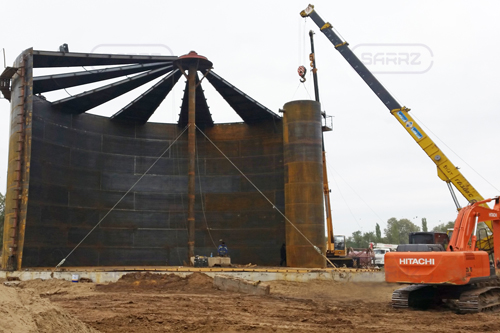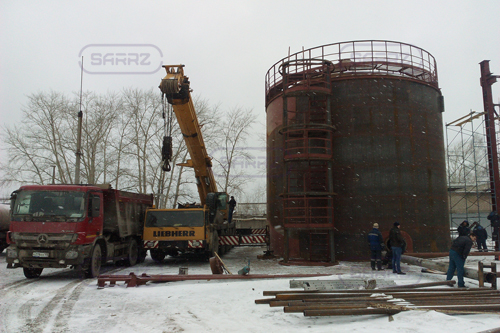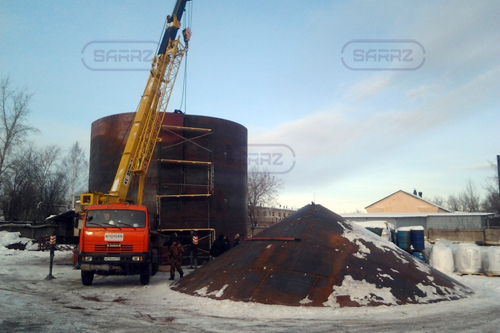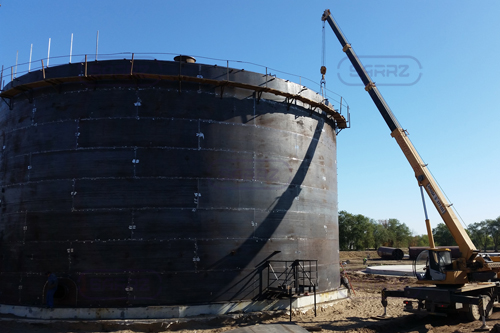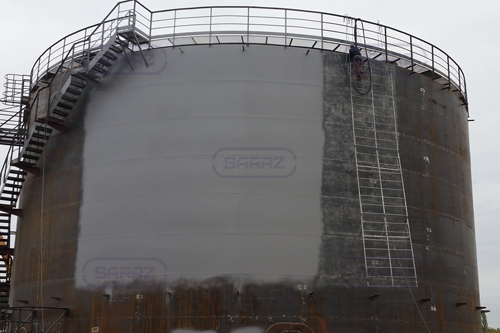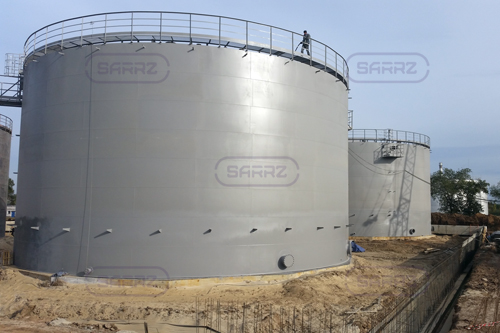Tanks and vessels erection
The Saratov Reservoir Plant performs vertical and horizontal tanks erection and assembly, as well as vessel equipment installation for any oil and gas industries (tank farms, terminals, fire stations, storage plants, petroleum-storage depots, etc.). We offer services for the tanks erection of our own production, as well as of the Customer's vessels and contract supervision.
Assembling and installation works are implemented in conformity with Certificate of clearance for classes of work which exercise influence upon site security of capital facilities, including highly dangerous and technically challenging (№ 0401.01-2016-6451451695-С-193).
Stages of tanks and vessels installation
Tank erection is time-consuming work. Safe operation of the tanks (provided that the operating rules are observed) depends on the quality of its performance.
Nominally, the installation works consist of three main stages:
- predevelopment and foundation mattress
- tanks and vessels erection
- testing
All work is carried out in accordance with the technological chart, as well as Method statement and the construction project design, which are part of the construction design documents. The main as-built documents, which go with all installation works, are records, logs and final completion protocols, test certificates, examination certificates and tanks as-built drawing.
Method Statement is developed on the basis of the Metal Structure design. The Method Statement contains information on the procedure and rules for conducting all assembly and welding operations using the necessary equipment, tests, measures to ensure the required accuracy and quality of welding and assembly of metal structures, safety at the facility, etc.
Choosing erection method, engineers are are ruled by the following standards:
- VSN 311-89 "Vertical steel tanks erection for petroleum products storage with the capacity from 100 to 50000 м3"
- GOST 31385-2016 "Vertical cylindrical steel tanks for petroleum products. General technical specifications"
- STO-SA-03-002-2009 Rules for design, fabrication and erection of vertical cylindrical steel tanks for petroleum products"
- GOST 17032-2010 "Horizontal steel tanks for petroleum products. Specifications"
In addition, the tank or vessel structural design (vertical, horizontal, spherical, aboveground, underground), site location, its remoteness and accessibility for heavy construction vehicles influence the list of works.
Preparation of the foundation for vertical tanks and vessels
Before starting tank erection, predevelopment occurs, the necessary auxiliary structures are erected, transport routes are brought in, engineering networks are connected.
The construction of the base and foundation is an important stage, since it affects the speed and uniformity of the segregation, and, therefore, the preservation of tank geometry and stability. The technology of base and foundation preparation depends on the weight of metal structures and the quality of the soil. If the soil does not have sufficient load-carrying capacity, the soil is consolidated, compacted or even replaced, together with diverting of ground water.
Traditionally, the tanks with a volume of up to 5000 m3 are erected on a foundation soil at a slope of 1:50 from the center to the periphery with a sand blanket (up to 2 m thick) and a hydrophobic (waterproofing) layer of a mixture of soil, bitumen, tar, hydron or fuel oil (up to 200 mm thick ).
Tanks with a volume of more than 10,000 m3 are additionally mounted on a circular reinforced-concrete foundation, located along the perimeter of the shell to load accommodation from it.
For weak soils, it is possible to construct pile foundation, which is covered with reinforced-concrete slabs from above.
Only after base and foundation acceptance tanks and vessels erection and installation is carried out.
Vertical tanks erection by rolling-up method
This method is to deliver tank shell to the construction site, rolled up. The bottom can also be supplied in roll form (up to 12 m in diameter) or, like a roof, with enlarged elements. Preliminary welding of the shell, bottom and roof is carried out at the Plant, which significantly shortens the performance time.
The bottom elements are installed, fastened and welded to the concrete or ground base: the edges (i.e. the peripheral sheets) first, and then the central part. Further, a shell is erected in the vertical position. A permanent or temporary bracket (rack) is mounted in the center for mounting of the fixed roof: constant for vertical tanks up to 5000 m3, temporary - for vertical tanks with a volume of 10000-20000 m3. Then the shell is unfolded around the perimeter and is welded with vertical and double sided T-butt weld, while the shell permanent position and stability are observed by fixing it with retainer locks made from the rolled angles. Simultaneously fixed roof panels assembling is carried out. Floating roof and pontoon are mounted immediately after the installation of the bottom. If necessary, stiffener rings are installed along the perimeter of the upper edge of the tank.
All hoisting is carried out using heavy equipment: tractors, haul trucks, self-propelled and tracked cranes.
Tanks erection by plate-by-plate method
This method includes the step-by-step assembly of individual elements of the shell with a size of 2000x8000 mm or 1500x6000 mm. Tank rings assembling starts from the lower one. It is possible to pre-aggregate the elements on the construction site: for example, first two sheets are welded to each other on the stand, and then are welded to the already erected shell.
Tank erection by bolted or rivet joints
One of the plate-by-plate methods is bolted connection of shell elements. This method is very advantageous for installation in areas where it is difficult or practically impossible to provide an access to heavy construction machinery and equipment. When choosing this method, the tank shell is delivered to the construction site in disassembled form and represents the required number of rectangular metal blanks of the required size. Tank foundation is prepared as well as for installation by roll-up.
The shell erection is carried out by the method of nurturing or extending the rings. Initially the first ring is welded. Then, depending on the design, two options are possible:
- the next ring is welded on the top of the first one: thus, each subsequent ring is located above the previous one
- each subsequent ring is welded under the previous one, that is, the first welded ring becomes the last one and will be directly under the roof
When bolting and riveting of tanks metal structures, much attention is paid to the quality of the surfaces to be joined, the strength of bolts, rivets, nuts and washers, since the integrity of the entire structure depends on their strength throughout service life.
Spherical storage tanks erection
A spherical tank is a necessary number of petals or blocks that form a sphere when they are joined together. All metal elements are delivered to the construction site prepared for welding, that is, the edges have a V- or U-shaped treatment.
First, a concrete foundation is set up, where fixings and a base setting ring are pre-laid. After the foundation is hardened, the bottom is installed, and then the petals of the rings. The petals can be assembled starting from the equatorial ring (tanks up to 18 m in diameter) or from the lower ring (tanks with a larger diameter). Metal elements are first assembled, their geometry is reconciled, and only then the welding is carried out.
Tanks anticorrosion treatment and testing after erection
After the installation works are finished, the surfaces are cleaned, and then their anticorrosion treatment with a primer takes place.
Before the tanks are set to work, hydrostatic test and hydroproof testing are carried out: vertical tanks are filled with water to the design level, horizontal and spherical - filled with water at a pressure exceeding the working one. The roof is inspected by pouring water up to the roof level, thereby increasing the internal pressure on the roof.
Aboveground horizontal tanks and vessels mounting
Horizontal aboveground vessels are delivered to the construction site in full factory readiness. They are installed on the reinforced-concrete foundation with the help of cables that are sewn into the lifting lugs welded to the shell at the Plant.
The shell is rigidly fixed to the foundation by saddle or rack supports using anchor bolts to prevent rollover in case of large wind loads.
Underground tanks and vessels assembly
Underground vessels are delivered to the place of operation in full factory readiness, which shortens installation work period. In addition, the underground location allows to install tanks in close proximity to residential or explosive objects.
Installation of underground tanks is carried out in accordance with GOST 17032-2010 “Steel horizontal tanks for petroleum products. Specifications”, in which it is stated:
- tanks are installed in a dug ditch for foundation on a sand blanket with a thickness of at least 200 mm
- the necks, manholes and nipples should be 200 mm above ground level
- the shell must be below the frost depth
In case of using underground tanks in the northern regions, the foundation pit should be equipped with a heating system.
If a high level of groundwater is observed in the operation area, the tank shell is rigidly fixed to the reinforced-concrete foundation by means of cables and anchor bolts. This prevents the container from being squeezed out.
From above underground tanks are covered up with sand and cement-sand soil with regular packing of layers.
For group layout of underground tanks, it is recommended to arrange concrete walls or rings that will protect the shell from high ground pressure.
After the completion of construction and installation works on vertical / horizontal / spherical aboveground or underground tanks, installation of process equipment, all routine maintenance in accordance with the project of construction works, the construction facility undergoes plant handover / sign off and, if necessary, the supervisory authorities.
How to calculate the cost of tank and vessels erection, installation or mounting?
In order to find out the cost of vertical or horizontal, above-ground or underground tanks, vessels assembly, You can:
- call at +7(8452)250-288
- email technical information and installation requirements at
- use the "Order a service" form
The advantage of working relationship with our Plant is the opportunity to order all works, apart from installation, namely: the design of tanks steel structures, their manufacture, delivery. The packaged order of tanks "turnkey" will save you time and money, since there is no need to search for contractors for each type of work.
The equipment of your interest You can find in our Catalogue
